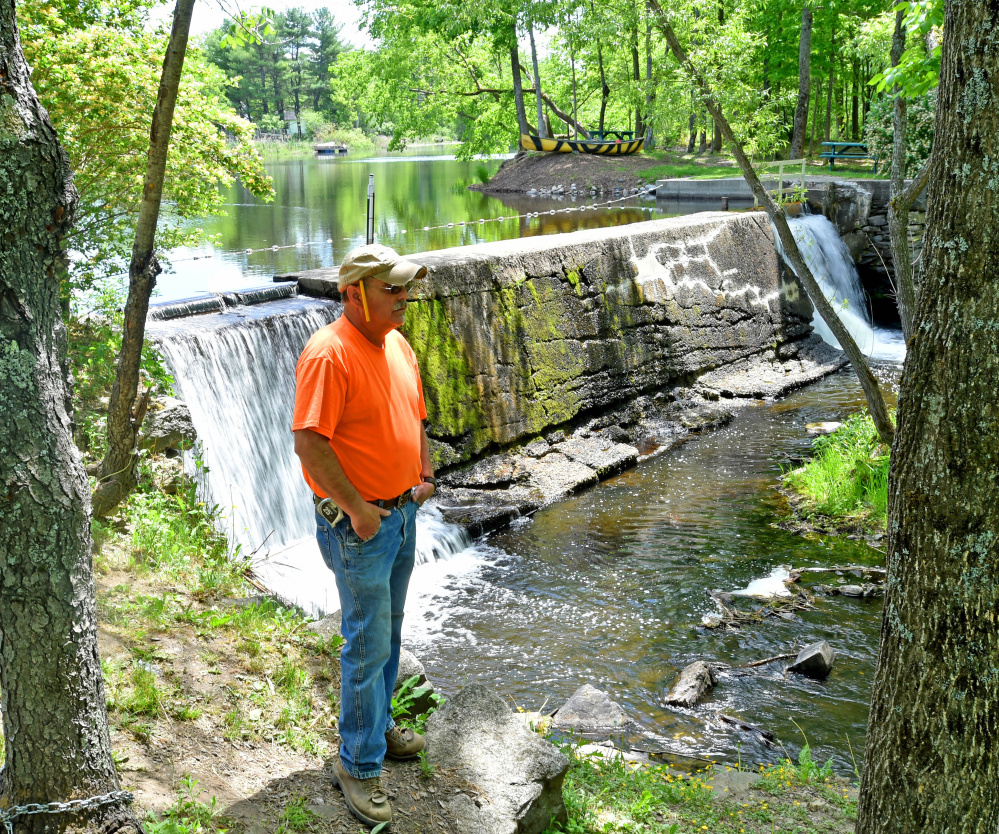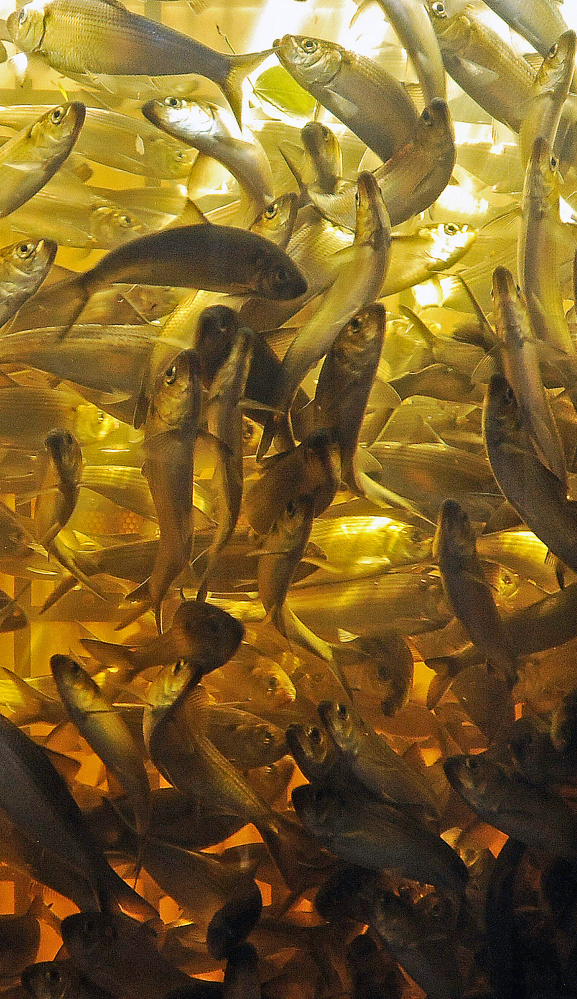VASSALBORO — Larisa Batchelder and her family can fish, kayak or swim in their backyard, thanks to Outlet Stream, a tributary of the Sebasticook River that runs behind their home on Main Street.
But Batchelder and others are worried that could change this summer, when a proposed alewife restoration effort would remove the nearby Masse Dam, which has held the water in a pond for years and stabilized the water level in her backyard and those of her neighbors.
She and her neighbors are worried the change – the result of a state order regulating water release from China Lake – will reduce water levels, lower their property value and affect wildlife.
“We’ve waited all winter for this,” said Batchelder, 37. “We finally get to use the stream, and now someone is going to take it away.”
Officials associated with the project agree that the loss of the dam probably will mean the loss of Mill Pond, which it has been holding in place for years, but say it also will restore the health of the ecosystem.
The Alewife Restoration Initiative, a partnership of six environmental and government agencies, is aimed at allowing alewives, small migratory fish commonly used as lobster bait, to return to China Lake to spawn. Those involved with the project say the benefits are vast and that while water levels may change, there is no need for residents to be overly concerned.
Removing three dams and modifying the other three that stand between the lake and the Sebasticook will cause the stream to revert to a more natural state while still keeping with state regulations for minimum water flow, officials with the project say.
And while Mill Pond probably will disappear, the plan is expected to boost the health of the stream and of China Lake – which is damaged by phosphorus levels that the little fish are expected to help alleviate – as well as help restore alewives to their natural habitat, which now is blocked by dams that were put in place to power mills along the stream.
“It’s a really exciting project and a rare opportunity to restore a large number of migratory fish, particularly alewives,” said Landis Hudson, executive director of Maine Rivers, one of the six groups that make up the ARI. “In the big picture, this is part of a larger restoration effort that’s been going on for many years.”
MAKING A COMEBACK
In 2000, the state dropped the minimum water flow from the lake to 10 cubic feet per second, and while normal water flow levels vary, the amount of water flowing through Outlet Stream most often varies between 15 and 20 cubic feet per second, according to data from the Kennebec Water District, which monitors the levels of China Lake and the amount of water that flows out of the lake.
ARI officials said they will be required to continue to comply with the state’s minimum flow requirements, which are unlikely to change because of the project.
But some residents say the dam removal will mean that even the same amount of water flowing through the area will translate to a change in the stream.
“It’s going to be a giant mudhole,” said resident Janet Babb, whose backyard borders the stream. “I’m not excited about it. I don’t think anyone who lives next to the stream is.”
Jeff LaCasse, manager of the Kennebec Water District, said that while the stream will still exist, the impoundments, or ponds, created behind the dams almost certainly will disappear.
“Some of the residents feel they shouldn’t lose those impoundments, but you’re not going to have those if you get rid of the dams,” he said.
Removal of the Masse, Morneau and Lombard dams is scheduled to take place this summer or in the early fall.
Two other dams – the Box Mill Dam and the Mill Stream Dam – will be modified to accommodate alewives after the dams’ owner, Ray Bretton, opposed removal because of their proximity to a popular swimming hole and recreation area that was created by the dams.
Don Robbins, who owns the Masse Dam, could not be reached for comment, but Hudson said a fish ladder at the dam was not feasible.
WATERWAY AS HABITAT
Some area residents also have said they are concerned about the effect of wildlife in the ponds created by the dams, particularly ducks and other waterfowl that have made the stream their home, as well as the possible introduction of non-native fish species.
Dwayne Rioux, a registered Maine Guide and outdoor writer who lives in Winslow, said residents are right to be concerned about the proposed dam removal, which he said will increase the likelihood of non-native fish species migrating upstream.
“When you introduce these exotic fish species, it screws up your whole fishery,” Rioux said. “If you’re going to gain something, you also have to look at what you’re going to lose.”
But officials from ARI say they plan to prevent the introduction of white catfish, common carp and northern pike into the stream via plans for a sorting station at the Mill Stream dam.
Jeff Nichols, a spokesman for the Maine Department of Marine Resources, another organization comprising ARI, said, “Restoring a natural water course has been shown to provide a more diverse and robust ecology, and to improve overall habitat.”
Charlie Hartman, a financial analyst who lives along a pond near the Masse Dam, said she has seen water levels go down if there is a leak in the dam or if it is lowered for repairs, and said there has been little communication with residents about what will happen if the dam is removed, even though officials say there have been several public meetings at the East Vassalboro Grange hall, and more communication with the public is planned.
“This is a wonderful habitat for ducks and beavers,” she said. “All of those habitats would disappear, and I think that would be horrible. I love this pond.”
COMMUNITY SUPPORT
Beth Callahan, project manager for the Bureau of Land Resources in the Maine Department of Environmental Protection, said the Outlet Stream project was approved for grant funding through the department’s Maine Natural Resource Conservation Program in December and that an approval committee had no environmental concerns about the project at the time of review.
Before the start of the project, the department and the U.S. Army Corps of Engineers will review a restoration plan and a Natural Resources Protection Act application also will need to be submitted.
Callahan said last week that the department has not received the application yet.
Many members of the community, as well as the six groups involved in the coalition, have said they support the project, Hudson said, and they hope to get more people on board.
The project recently received financial support from the town of Vassalboro, where selectmen voted to support the ARI project with $85,000 in economic development money. The money was approved May 5 after a public hearing in April. No one spoke against the project at the public hearing.
Residents at the 2015 town meeting also voted to give money to the effort.
But not everyone is convinced of the project’s merits.
Bill and Roxanne Pullen own property along the stream across from the garage they operate, Freddie’s Used Cars and Body Shop, on Main Street near the Masse Dam. They said they think the motivation behind the alewife restoration is mostly commercial, not environmental, and they don’t want to see the area change.
“It’s not like we’re against the alewives,” Roxanne Pullen said. “We just don’t want to lose the ducks and other wildlife.”
“We don’t want to lose our scenic town with a stream running through it,” Bill Pullen said.
Send questions/comments to the editors.





Success. Please wait for the page to reload. If the page does not reload within 5 seconds, please refresh the page.
Enter your email and password to access comments.
Hi, to comment on stories you must . This profile is in addition to your subscription and website login.
Already have a commenting profile? .
Invalid username/password.
Please check your email to confirm and complete your registration.
Only subscribers are eligible to post comments. Please subscribe or login first for digital access. Here’s why.
Use the form below to reset your password. When you've submitted your account email, we will send an email with a reset code.